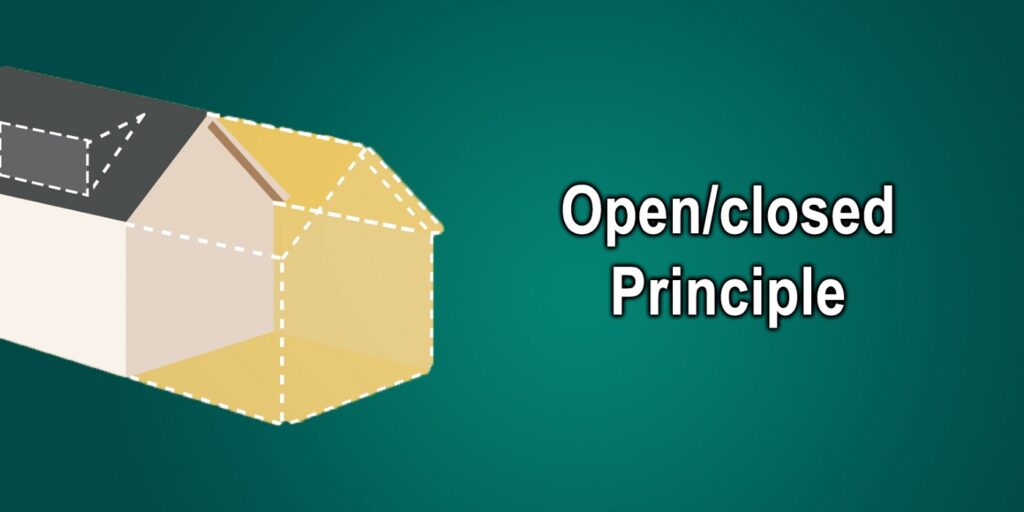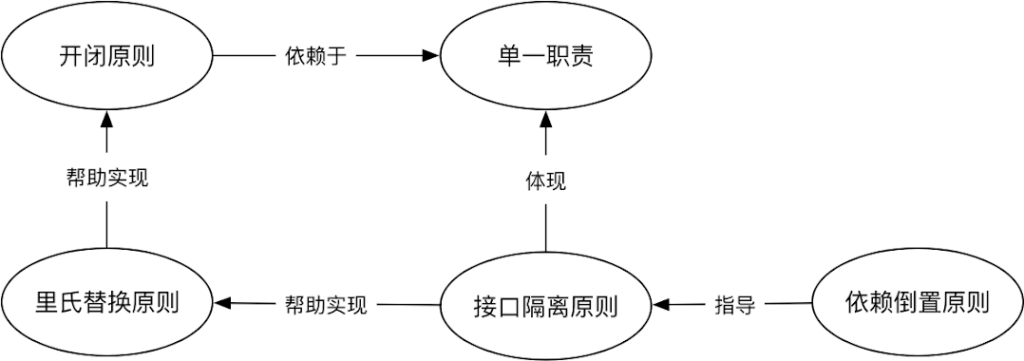我不是一个正经的SEO优化人员,今天要分享的是SOLID原则,如果有了解过软件设计模式和面向对象编程(OOP)的同学应该不会陌生,当我们编写软件,需求和功能在不断变化增加的时候,就会发现原来面向过程的编码方式是多么难扩展和维护,有想法的开发人员就会寻求更好的开发模式和方法,这时候S.O.L.I.D就会向我们伸出双臂,首先来了解下,SOLID的缩写(acronym)都代表什么意思:
- S - Single Responsibility Principle 单一职责原则
- O - Open Closed Principle 开闭原则
- L - Liskov Substitution Principle 里氏替换原则
- I - Interface Segregation Principle 接口隔离原则
- D - Dependency Inversion Principle 依赖倒置原则
我会用相应的PHP示例代码讲解这五个原则,希望看完这篇文章,能把这5种设计理念运用到平时的工作生活中,学以致用才有价值,其中最好理解的应该是单一职责原则其他从字面意思,可能不太好理解,没有关系,跟着我一起学习,也可以收藏页面,偶尔回来看看,加深下印象。
单一职责原则

单一职责原则SRP
单一职责原则(SRP)的核心内涵就是:一个类只负责处理好一件事。比如我是一名厨师,我就管煮菜,上菜这事就不归我管,也就是现代社会的工作细分。假设我们有一个User类,这是管理系统中很常见的类:
class User {
private $username;
// 其他属性方法...
public function save() {
// 把User存入数据库
}
}class User {
private $username;
// 其他属性方法...
public function save() {
// 把User存入数据库
}
}可以看到这个save方法就不满足User类的SPR原则,这个功能应该由数据库操作的类来承担,所以我们把他们分离:
class User {
private $username;
// 其他属性方法...
}
class UserDB {
public function save(User $user) {
// 把User存入数据库
}
}class User {
private $username;
// 其他属性方法...
}
class UserDB {
public function save(User $user) {
// 把User存入数据库
}
}开闭原则

软件架构开闭原则
开闭原则(OCP)的核心内涵是:对扩展开放,对修改封闭。比如说我们有如下类:
<?php
class Rectangle {
public $width;
public $height;
public function __construct($width, $height) {
$this->width = $width;
$this->height = $height;
}
}
class Square {
public $length;
public function __construct($length) {
$this->length = $length;
}
}
class AreaCalculator {
protected $shapes;
public function __construct($shapes = array()) {
$this->shapes = $shapes;
}
public function sum() {
$area = [];
foreach($this->shapes as $shape) {
if($shape instanceof Square) {
$area[] = pow($shape->length, 2);
} else if($shape instanceof Rectangle) {
$area[] = $shape->width * $shape->height;
}
}
return array_sum($area);
}
}<?php
class Rectangle {
public $width;
public $height;
public function __construct($width, $height) {
$this->width = $width;
$this->height = $height;
}
}
class Square {
public $length;
public function __construct($length) {
$this->length = $length;
}
}
class AreaCalculator {
protected $shapes;
public function __construct($shapes = array()) {
$this->shapes = $shapes;
}
public function sum() {
$area = [];
foreach($this->shapes as $shape) {
if($shape instanceof Square) {
$area[] = pow($shape->length, 2);
} else if($shape instanceof Rectangle) {
$area[] = $shape->width * $shape->height;
}
}
return array_sum($area);
}
}AreaCalculator类是用来计算不同形状的面积,现在只有正方形和矩形,那如果我们要加一个圆形怎么办?一般的方法肯定是添加一个圆形类,然后再去修改sum方法,但是如果我再添加一个梯形呢?三角形呢?这样加下去是不是每次都要改sum代码,这就违反了开闭原则中对修改封闭的意思,那如何解决?也很简单,就是对扩展开放,代码作如下修改:
interface Shape {
public function area();
}
class Rectangle implements Shape {
private $width;
private $height;
public function __construct($width, $height) {
$this->width = $width;
$this->height = $height;
}
public function area() {
return $this->width * $this->height;
}
}
class Square implements Shape {
private $length;
public function __construct($length) {
$this->length = $length;
}
public function area() {
return pow($this->length, 2);
}
}
class AreaCalculator {
protected $shapes;
public function __construct($shapes = array()) {
$this->shapes = $shapes;
}
public function sum() {
$area = [];
foreach($this->shapes as $shape) {
$area[] = $shape->area();
}
return array_sum($area);
}
}interface Shape {
public function area();
}
class Rectangle implements Shape {
private $width;
private $height;
public function __construct($width, $height) {
$this->width = $width;
$this->height = $height;
}
public function area() {
return $this->width * $this->height;
}
}
class Square implements Shape {
private $length;
public function __construct($length) {
$this->length = $length;
}
public function area() {
return pow($this->length, 2);
}
}
class AreaCalculator {
protected $shapes;
public function __construct($shapes = array()) {
$this->shapes = $shapes;
}
public function sum() {
$area = [];
foreach($this->shapes as $shape) {
$area[] = $shape->area();
}
return array_sum($area);
}
}可以看到,sum方法内部已经不去判断是哪个形状,而是直接调用各自形状的area方法,这个方法是各种形状继承和实现Shape接口的,这样无论以后添加多少种形状,sum内部代码是不会改变的,只要添加新的形状类和实现各自的area方法就可以。
里氏替换原则

里氏替换原则LSP
里氏替换原则(LSP)的核心内容:子类可以替换父类的位置,系统一样可以正常运行。我们再拿前面的例子举例,我们发现正方形其实是矩形的一个子类,只是4条边都相等而已,那我们把代码改成如下:
interface Shape
{
public function area();
}
class Rectangle implements Shape
{
protected $width;
protected $height;
public function __construct($width, $height)
{
$this->width = $width;
$this->height = $height;
}
public function area()
{
return $this->width * $this->height;
}
}
class Square extends Rectangle
{
public function __construct($length)
{
$this->width = $length;
$this->height = $length;
}
}
class AreaCalculator
{
protected $shape;
public function __construct(Rectangle $shape)
{
$this->shape = $shape;
}
public function getArea()
{
return $this->shape->area();
}
}interface Shape
{
public function area();
}
class Rectangle implements Shape
{
protected $width;
protected $height;
public function __construct($width, $height)
{
$this->width = $width;
$this->height = $height;
}
public function area()
{
return $this->width * $this->height;
}
}
class Square extends Rectangle
{
public function __construct($length)
{
$this->width = $length;
$this->height = $length;
}
}
class AreaCalculator
{
protected $shape;
public function __construct(Rectangle $shape)
{
$this->shape = $shape;
}
public function getArea()
{
return $this->shape->area();
}
}之后我们可以使用AreaCalculator这个类去计算他们的面积,代码如下:
square = new Square(2);
$rectangle = new Rectangle(2, 4);
$areaSquare = new AreaCalculator($square);
$areaRectangle = new AreaCalculator($rectangle);
echo $areaSquare->getArea() ; // 4
echo $areaRectangle->getArea() ; // 8square = new Square(2);
$rectangle = new Rectangle(2, 4);
$areaSquare = new AreaCalculator($square);
$areaRectangle = new AreaCalculator($rectangle);
echo $areaSquare->getArea() ; // 4
echo $areaRectangle->getArea() ; // 8这里虽然参数是Rectangle类型,但是我们使用Square类也是可以,因为它是Rectangle的子类,里氏替换有几个注意的关键点:
- 子类的参数可以扩展
- 子类的返回参数可以比父类严格
- 不能改变父类的属性
子类参数可扩展,比如我们使用PHP8.0 新的特性 Union Types,如下代码:
class Foo {
public function process(int|float $value);
}
class Bar extends Foo {
public function process(int|float|string $value);
}class Foo {
public function process(int|float $value);
}
class Bar extends Foo {
public function process(int|float|string $value);
}这里我们必须继承所有父类的参数,之后扩展子类自己的参数。
返回参数可缩小,还是用Union Types特性来举例:
class Foo {
public function process(): string|int;
}
class Bar extends Foo {
public function process(): int;
}class Foo {
public function process(): string|int;
}
class Bar extends Foo {
public function process(): int;
}可以看到Bar::process方法的返回类型变成了int类型,比父类更为严格了,但是如果扩展返回类型是被允许的,所有以上三点都是为了保证在子类替换父类后,程序能够继续正常运行。
接口隔离原则

接口隔离原则
接口隔离原则(ISP)的核心思想是:不要继承和实现不需要的接口。再使用前面图形的例子来说明下,如果这时候我们要加入三维图形,三维的图形肯定也是有面积的,但是三维的图形还有容积,这时候我们就可能把接口修改如下:
interface Shape
{
public function area();
public function volume();
}interface Shape
{
public function area();
public function volume();
}但是这样就会有个问题,一维的图形可没有容积,却要实现容积的计算接口,那这就违反了接口隔离的原则了,这时候我们就要把这个接口分离成两个接口:
interface Shape
{
public function area();
}
interface ThreeDimension
{
public function volume();
}interface Shape
{
public function area();
}
interface ThreeDimension
{
public function volume();
}之后让不同的图形分别去实现这两个接口就好。
依赖倒转原则
依赖倒置原则(DIP)的核心内容是:对抽象编程,而不是对具体实现。意思就是外层模块不应该依赖内层模块,下面我用代码举例:
interface Payment
{
function pay($amount);
}
class CashPayment implements Payment
{
public function pay($amount)
{
// handle cash payment logic
}
}
function makePayment($amount, Payment $paymentMethod)
{
if ($paymentMethod->pay($amount)) {
return true;
}
return false;
}interface Payment
{
function pay($amount);
}
class CashPayment implements Payment
{
public function pay($amount)
{
// handle cash payment logic
}
}
function makePayment($amount, Payment $paymentMethod)
{
if ($paymentMethod->pay($amount)) {
return true;
}
return false;
}可以看到我们这里只有现金支付这么一个方法,如果再加一个信用卡支付,只要继承支付接口,然后调用的时候传入信用卡支付类,和前面说到得开闭原则很类似吧?没错,其实这些原则的关系都是相辅相成的:

SOLID原则关系
依赖倒转原则这种思想被用的具体实现就是依赖注入,依赖注入降低了模块之间的耦合关系,我们软件设计的目标就是高内聚,低耦合,今天的分享就到这,有什么不懂得可以评论留言,其实每一个原则要是细讲还有很多东西可以说,以后我会分篇来分享。
 Hello Yu
Hello Yu